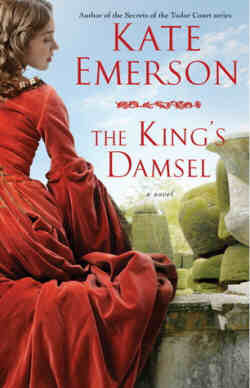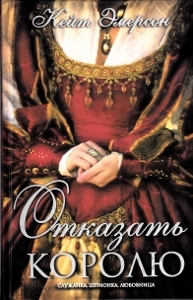Found in Translation
 Kaitlyn Dunnett/Kathy Lynn Emerson here. The contents of this post have been in my “blog topics” file for quite a while now. I’ve been trying to decide if this topic was blogworthy or not. I alternate between thinking this text is hilarious and worrying that people will think I am poking fun at those whose first language is not English. Seriously—no disrespect is intended. In fact, the Russian edition of The King’s Damsel, one of the historical novels I wrote as Kate Emerson, is my one and only genuine best seller. It was a book club selection and as such sold more copies than any other single book I’ve written.
Kaitlyn Dunnett/Kathy Lynn Emerson here. The contents of this post have been in my “blog topics” file for quite a while now. I’ve been trying to decide if this topic was blogworthy or not. I alternate between thinking this text is hilarious and worrying that people will think I am poking fun at those whose first language is not English. Seriously—no disrespect is intended. In fact, the Russian edition of The King’s Damsel, one of the historical novels I wrote as Kate Emerson, is my one and only genuine best seller. It was a book club selection and as such sold more copies than any other single book I’ve written.
So, onward. The material below is the preface to that edition, translated from Russian into English and sent to me to make sure there were no glaring errors in historical fact. I was instructed not to change to text. As you will see, the wording in English is often . . . interesting, and reading this did make me wonder how well my words fared when translated into Russian, but all-in-all, it does sum up what happens in my story. Here goes:
Intrigues Behind the Throne
It seems rather difficult a task to find another period in the history of medieval England that has been constantly attracting writers as much as the times of King Henry the Eighth who ruled between 1509 and 1547. Such an obvious interest is provoked by a number of reasons, the Monarch’s private life being not the least of them. Six wives, one after another, are more than normal for any man. To follow all the intricate ways leading from divorces to new royal marriages is a real thrill both for authors and for their readers. Especially providing we do not forget that King Henry, not a man of virtue when it came to love affairs, sent to the scaffold two of his wives for having been unfaithful to the king, which crime then amounted to high treason.
Five years before his death, the august sinner was punished with obesity to such a degree that he lost the ability to walk, compelled to be pushed in a wheelchair. Yet, at the time The King’s Damsel by the U.S. author Kate Emerson is set King Henry VIII was still a very attractive man. Here, we see him through the eyes of the novel’s heroine, Thomasine “Tamsin” Lodge, who is the narrator of the story, and we have to agree that “his appearance never failed to arouse people’s admiration.” A big and very handsome man, a skilled rider, fencer and hunter, a true gallant, a witty man in a good company, an excellent dancer and a composer of refined music, Henry fails to win Tamsin’s sympathies on account of his single fault: His Majesty is going to get divorced from his legitimate consort, old Queen Catherine of Aragon, in order to marry Anne Boleyn who fascinates him beyond reason. The king is driven not by love only, but also by political considerations: he should have a son, an heir of the throne of England. If this desire of Henry’s comes true, Princess Mary, his daughter by Catherine, will lose her right of succession.
This divorce and subsequent marriage created a deep division within the royal household. Thomasine Lodge, who was orphaned at the age of 13 and then became, through her guardian’s efforts, a maid of honor of Princess Mary, got truly attached to Her Highness. She is ready for great sacrifices in the name of her mistress, for the sake of the latter’s well-being and happiness. A lot of crafty intrigues and artful designs await the reader’s attention — those flourishing at the court, among the ladies and cavaliers of the self-assured king and his Lady Anne, whose cleverness matched only her prescience, and those instigated by Princess Mary, who had to grow up far away from both her parents and to quickly learn the intricate ways behind the throne.
The King’s Damsel is abundant in details of ladies’-in-waiting everyday life, court rules and etiquette, state ceremonies. Life in the royal palace, so noble and dignified in its outward appearance, requires one always to be on one’s guard in order not to risk one’s career or even one’s own life. Tamsin, a young provincial girl, managed to win the Princess’s favor due to her talent to invent and tell stories while her mistress was extremely bored with her obligatory embroideries. As the years pass, she becomes a real master of survival at the court. Yet, she happens to have a tinge of adventurism in her nature — enough to start, very carefully (as she sees it herself), a risky game of her own…
Thomasine Lodge is a fictitious character created by Kate Emerson’s imagination. The author was guided by letters and reports of the Spanish ambassador to England, saying that some nameless but very pretty lady of the court happened to attract the king’s attentions and was almost banished by Queen Anne. Some other characters in the book are also fictitious but most of the characters in The King’s Damsel are real historical figures, and there are special references concerning them after the main text of the novel. Even so, it is hard to disbelieve the reality of Tamsin herself as she is described so vividly and convincingly. By the way, she is loyal to the Princess but not so fanatically as to forget her own future and her own happiness. As a rich heiress, she hates staying a puppet of her loathsome guardian. Due to author’s masterly plot, Tamsin’s fate excites the reader not less — even more — than that of royal characters. When some Rafe Pinckney, a young man with curly dark hair and a courageous look on his face with an aquiline nose, appears in the novel, a shrewd reader clearly understands that this man is destined to play a very important part in Tamsin’s further life. However, they have to undergo many an ordeal before the novel’s happy end.
Written in Russian, this preface appears to have attracted plenty of readers. Color me relieved. I’d love to hear what experiences other writers have had with translations. And if any of you, readers or writers, are fluent in another language, what has been your impression of books translated from English? I remember that back when I was writing romance novels, the French editions were always much shorter than the English versions. I never could figure out what it was that they cut.
P.S. The second Kate Emerson novel to be translated into Russian, At the King’s Pleasure, had only moderate success.
Kaitlyn Dunnett/Kathy Lynn Emerson is the author of over fifty books written under several names. She won the Agatha Award in 2008 for best mystery nonfiction for How to Write Killer Historical Mysteries and was an Agatha Award finalist in 2014 in the best mystery short story category for “The Blessing Witch.” Currently she writes the contemporary Liss MacCrimmon Mysteries (The Scottie Barked at Midnight) as Kaitlyn and the historical Mistress Jaffrey Mysteries (Murder in the Merchant’s Hall) as Kathy. The latter series is a spin-off from her earlier “Face Down” series and is set in Elizabethan England. Her websites are www.KaitlynDunnett.com and www.KathyLynnEmerson.com
Lea Wait's Blog
- Lea Wait's profile
- 506 followers






